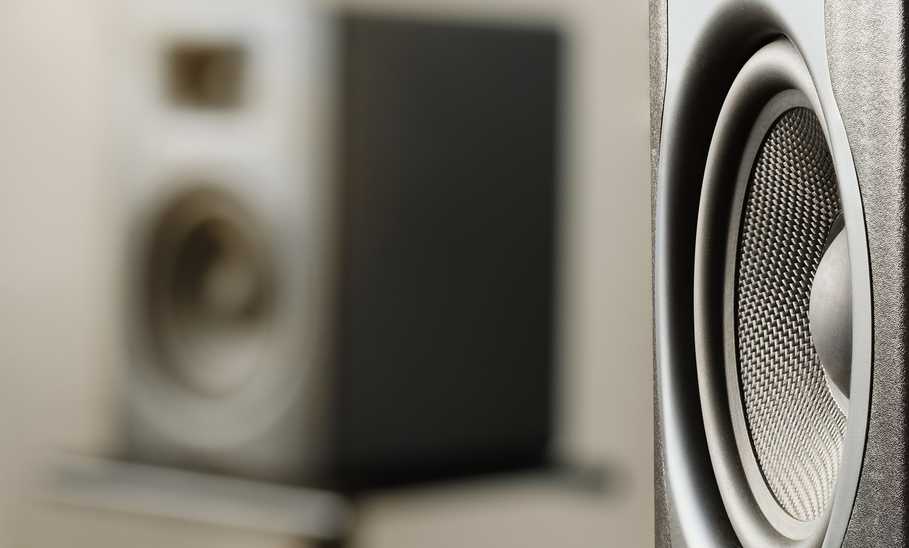Soundbar vs Speakers: What’s the Right Sound System for You?


Our evaluations and opinions are not influenced by our advertising relationships, but we may earn a commission from our partners’ links. This content is created by TIME Stamped, under TIME’s direction and produced in accordance with TIME’s editorial guidelines and overseen by TIME’s editorial staff. Learn more about it.
Few things can provide an escape like kicking back with a tub of popcorn at your favorite movie theater. But, the right sound setup can help you bring movie night into your own living room. A simple soundbar can take home entertainment to the next level, but there are times when speakers are necessary, as well. So, what’s the difference between a soundbar and speakers?
We reached out to audio experts to help walk us through the distinction so you can choose the right sound system for you and your home.
Soundbars are a quick, affordable way to upgrade the audio in your home. If it’s between relying solely on the built-in speakers on your TV and routing audio through a soundbar, the soundbar wins, every time.
However, soundbars do have some downsides. It’s important to fully assess your audio needs before you invest in a soundbar. This breakdown will help you learn what to consider if you’re weighing soundbars against speakers.
Traditional speakers can add bulk to your environment, going against a room’s design aesthetic. A soundbar packs multiple speakers into one compact cabinet, letting it rest discreetly under your TV, inside an entertainment cabinet or on a wall nearby.
A soundbar typically contains the primary speakers necessary for crisp, clear audio. If you took a soundbar apart, you’d find:
Christian de Looper, consumer technology expert at HostingAdvice, sees soundbars as a solution that works for most consumers.
“The vast majority of users should simply buy a soundbar, or a soundbar system with a subwoofer and rear speakers,” he says. “They’re easier to set up and use and don’t require any additional equipment.”
Some soundbars use something called virtual surround sound, which modifies sound waves to make audio seem as though it’s coming from different areas of the room. While it can do an adequate job of emulating the movie theater experience, it will never be as good as a true surround sound setup.
Speaker setup can be complicated, particularly if you purchase a receiver. The best soundbars remove that complication, getting you up and running in a matter of minutes.
“The best thing about soundbars is that they’re always ready to go,” says de Looper. “Plug them into power, and then into a TV, and they’ll play audio straight from your TV.”
Speakers consume space. Even small speakers are larger than the typical soundbar. The compact form of a soundbar makes it easy to set up just below your TV, where it may even blend with the bezel.
“Soundbars excel in smaller rooms or apartments since they don’t take up much space,” explains Shaun O'Brien, founder and managing director at Selby Acoustics.
When comparing soundbars to speakers, soundbars often fall short. However, if you’re going directly from the built-in speakers on your TV, you’ll notice a considerable improvement.
“Soundbars offer simplicity for those who desire better sound quality without any complications as they are easy-to-use gadgets that can improve television’s audio within a few minutes of setting up,” O'Brien advises.
Speaker systems can top $1,000, particularly those on the higher end. Soundbars, on the other hand, typically run in the hundreds. The best thing about soundbars, though, is that you can get multiple speakers in one unit, versus the separate speakers you’d have to purchase for the same setup.
“Soundbars are perfect for people who love convenience and need to save on space or money,” O'Brien says.
Connectivity is another feature soundbars often boast. Your soundbar will likely occasionally need firmware updates, and a Bluetooth connection can help make that easier.
“Bluetooth is a very common feature to find on almost every soundbar, but you may want to consider one that has WiFi built in as well,” urges Carl Prouty, tech and retail expert at Abt Electronics. “That will help keep the software up to date, and often gives you access to additional features.”
One downside of soundbars is that they limit your options. If you’re purchasing multiple speakers to station around your room, you have the option to customize your setup. However, as Tony Ostrom, president of the Wireless Audio and Speaker Association, points out, you can always supplement your soundbar with speakers that offer the audio experience you prefer.
“You may want to simply add a subwoofer for low-frequency extension,” says Ostrom. “Or you may want to add rear channels to create depth in the listening experience.”
Whether you want to recreate a three-dimensional movie theater-like experience, “a universal, interoperable, wireless audio approach allows consumers to build the system that is right for them and install it and control it with ease,” says Ostrom.
The truth is, the same technology packed into a soundbar won’t be as good as the best speakers. However, the best soundbars can hold up well against lower-tier speakers. If you’re a true audiophile, you’ll want to stick with traditional speakers.
“Speakers, particularly multi-channel setups, offer better sound quality than soundbars,” says O'Brien. “These flesh out a wider soundstage with greater clarity and are thus suitable for those who value the best theater experience. Speakers allow you to distribute them throughout the room, which creates an immersive effect that soundbars do not offer.”
Many soundbars use downward-firing subwoofers, which don’t pack as much bass as a subwoofer with a front-firing driver. However, this can vary from one soundbar to the next.
“Ideally, you want a soundbar that is at least 3.1 channels,” Prouty says. “This gives you a left, center and right channel, along with a subwoofer. The dialog comes through more clearly and you'll get more bass.”
A speaker, simply put, converts an audio signal into sound. The signal needs an original source, such as a TV, a mobile device or a voice through a microphone. For a truly immersive experience, you’ll need multiple speakers, each bringing its own contribution.
The problem with speakers is that you typically can’t get by with only one.
Here are the major components of a speaker system:
Most speaker setups utilize something called passive speakers which allow you to power up all your speakers automatically at once. To accomplish this, speakers typically communicate with something called a receiver. You can find receivers for less than $300, but a higher-tech version will likely run you in the thousands.
“Typically, these types of systems are built with passive speakers, powered by external amplification commonly housed in an audio video receiver (AVR),” Ostrom says. “The complexity of these systems, driven by the need to include an AVR and run speaker wire to every passive speaker, creates a barrier to entry that simpler systems like soundbars drastically reduce.”
The center speaker in a home theater does some important work. This is where most of the dialogue is processed. If possible, match your center speaker to the left and right speakers to get the ideal blend.
The two speakers on either side of a screen in a home theater are called the front speakers. These two speakers take care of a variety of tones, which is why it’s ideal that they blend well with your center speaker. You can buy tower-style floor speakers or smaller speakers designed to rest on bookshelves or on top of your entertainment cabinet.
In a surround sound system, rear speakers operate similarly to front speakers, only these are placed behind you. This makes it seem as though the audio is happening all around you, fully immersing you in the experience.
The deeper frequencies in a home theater setup are processed by the subwoofer. Typically resting toward the back of your seating area, a subwoofer can often create a vibration that can be felt when you’re near it. Subwoofers are meant to complement an existing home theater setup, whether you’re using a soundbar or investing in a full home theater setup.
Soundbars have plenty of benefits, but for the true audiophile, a top-notch speaker setup will be the best option. As de Looper points out, though, it all depends on how much you’re willing to spend.
“These days, soundbars are often a better choice for general consumers, but audiophiles or those willing to spend more time and money on a high-end home theater may want to consider speakers,” de Looper explains. “High-end speakers often sound better than soundbars. If you spend the time and money on high-end speakers and a great receiver, you can get stunningly detailed and clear audio.”
Experts use a term called “soundstage” to describe how a speaker distributes sound. A good speaker can easily separate audio designed to be to the left and right, so that the listener feels as though the sound is coming from either side.
While soundbars have done a great job of emulating this, in the end, it’s still a virtual version. For a truly immersive experience, having speakers stationed at different spots in your room is the best way for the sound to be separated. As Ostrom explained, today’s entertainment options demand a speaker setup to support it.
“Content across multiple genres, including movies, TV shows, gaming, music and sports, is produced in immersive, multi-channel audio formats,” Ostrom says. “It is ideal to enjoy this content with a true multi-channel audio system that creates a wide front stage with separate speakers, depth of field with surround/rear speakers, low-end frequency extension with a subwoofer, wide frequency response across the entire system and appropriate output volume capability.”
Another big benefit to speakers is that you can customize your setup. While you can buy entire home theater systems, you can also purchase your subwoofer, front speakers, center speaker and receiver separately, allowing you to put together exactly the sound experience you prefer.
In addition to performance, you can also customize the look of your home theater. Speakers come in a variety of colors and sizes, so it’s important to take your decor into consideration when you’re picking out speakers.
“In selecting this kind of item, one needs to look at their room size, along with TV measurements,” O'Brien says. “It must be aesthetically compatible with your interior design.”
If you want the true surround sound experience, a multi-speaker setup is the best option. Having speakers physically surround you can help immerse you in a movie, TV show or video game. However, as Prouty points out, for some consumers, picking out and setting up that home theater can serve as a challenge.
“A separate speaker system makes sense for people looking for the best surround sound experience,” he explains. “Some people also enjoy the process of setting them up and getting them dialed in just right. It's kind of like driving a manual transmission car versus an automatic. It's more hands-on.”
One thing the best soundbars have that speaker systems don’t is ease of setup. No matter which speaker set you choose, you can expect a little work on the front end. You can ease the setup process a little by choosing speakers that are passive rather than active.
“Most speakers built for use with a TV are indeed passive, but some are active—and if you use active speakers, you’ll need to plug each speaker into a power outlet and turn them on each time you use them,” de Looper cautions.
For some people, the decision to go with a soundbar over a speaker comes down to budget. A good speaker setup will cost well into the hundreds, if not thousands, of dollars. A good soundbar will cost significantly less.
“Speakers tend to cost more, especially if you have to purchase amplifiers/receivers separately,” O'Brien says. “Speakers make sense for larger rooms where superior sound quality is a priority and you have the time and budget to invest in a more complex setup.”
One soundbar benefit gets mentioned often, and that’s its compact size. There’s a reason for that. To get the equivalent sound quality from a speaker system, you’ll need a center channel and two front speakers, and even bookshelf-sized speakers take up space.
Finding room for speakers gets even more complicated when you’re trying to boost your audio quality. Experts recommend very specific placements for speakers, and that can mean having to build shelving or mount speakers from your ceiling.
“We are also seeing content across multiple genres include a third dimension of height, which involves either speakers located near or in the ceiling or speakers aimed up so as to bounce sound off of the ceiling,” Ostrom advises. “Like the rest of the speakers in the system, it is beneficial for these height speakers to be separated from each other by a decent distance.”
The top reason to go with a speaker system over soundbars is to achieve true surround sound. If this is important to you, the choice is a no-brainer. However, the best soundbars do a great job of emulating surround sound, making it an acceptable choice for most consumers.
“What’s important, though, is thinking about what we will mostly be using our home theater systems for—movies, music or gaming,” O'Brien says. “Depending on their various requirements can make one system more ideal than another one.”
You don’t have to live in a studio apartment to be limited on space. You may simply look around your living room and find little to no room for audio equipment. When space is scarce, a soundbar can be the best option.
However, it’s important to note that soundbars have their issues, too. As de Looper points out, soundbars aren’t very versatile in their placement.
“You’ll generally want to place a soundbar under your TV, and you often won’t want to place it inside a TV stand, especially if it has speakers that play to the sides and toward the ceiling, as is the case in a soundbar that supports Dolby Atmos,” he cautions.
If you’re the type of entertainment consumer who wants a simple way to improve your TV audio, a soundbar is likely the best option. You’ll just remove it from the box, plug it in and connect it to your TV. In many cases, you’ll have to do minimal tweaking to get the desired sound output.
“However, straightforwardness has its price,” O'Brien adds. “A soundbar cannot deliver the same audio quality as a multi-speaker system. They have limitations in terms of soundstage and depth that can be noticeable, especially during complex music pieces or action-packed movie scenes.”
As great as an impressive surround sound system can be, the truth is, the price point is out of reach for many consumers. Yes, you can find more affordable speakers, but you’ll likely get more out of looking at some of the best soundbars and comparing their offerings to what you get from a budget speaker.
“Soundbars are available in a large range of sizes, price points, channel configurations, feature sets and design languages, allowing consumers to pick the right solution for their space, goals and use cases,” Ostrom says.
Yes, true audiophiles won’t settle for anything, but a top-notch system. However, most consumers aren’t that serious about their audio. In fact, for many, the convenience of easy setup and the small footprint make soundbars a better option. If a space-saving design and ease of use are more important to you than a home theater experience that rivals a trip to the cineplex, a soundbar is probably best.
While you can find speakers for every budget, you’ll likely get more bang for your buck by going with a soundbar. That said, if you’re interested in true surround sound, compare the technology of any soundbar you’re considering to speaker systems at a similar level to make sure you’re getting the best option for what you’re spending.
When it comes down to it, it’s important to ask yourself why you’re investing in a sound system. If you want to escape into a surround sound-intensive action film after a long, hard week, a soundbar likely won’t suffice. If you simply want to enjoy your favorite reality TV shows or catch up on the day’s news, a soundbar should do just fine.
If audio is a passion for you, a soundbar likely won’t cut it. With speakers, you can set up the environment you prefer, whether you plan to use it for movies and TV shows, gaming or music. Speakers are also the best option if you want to be able to customize your listening experience.
For those interested in surround sound, speakers are the best way to go. When set up properly, a speaker system will immerse you in the entertainment you’re consuming, which is especially important with the way movies and music are produced.
If soundbars are best for those who are short on space, speakers are ideal for those who have a little extra room. They can work fine in a living room or wherever else your household members gather, but they’re especially useful if you’re setting aside a room for a home theater.
Combining a soundbar and speakers can be complicated, but when done correctly, it can work. O'Brien says most modern soundbars are set up to work with wireless back speakers and a subwoofer, which can help you create that surround sound experience.
“All parts of the joint system must be compatible,” O’Brien stresses. “If possible, use the same brand or ecosystem so that there is no problem with connectivity. Proper placement still matters for speaker units, even in hybrid systems. Hence, rear speakers should be placed at ear level and angled toward the seating area.”
The information presented here is created by TIME Stamped and overseen by TIME editorial staff. To learn more, see our About Us page.



